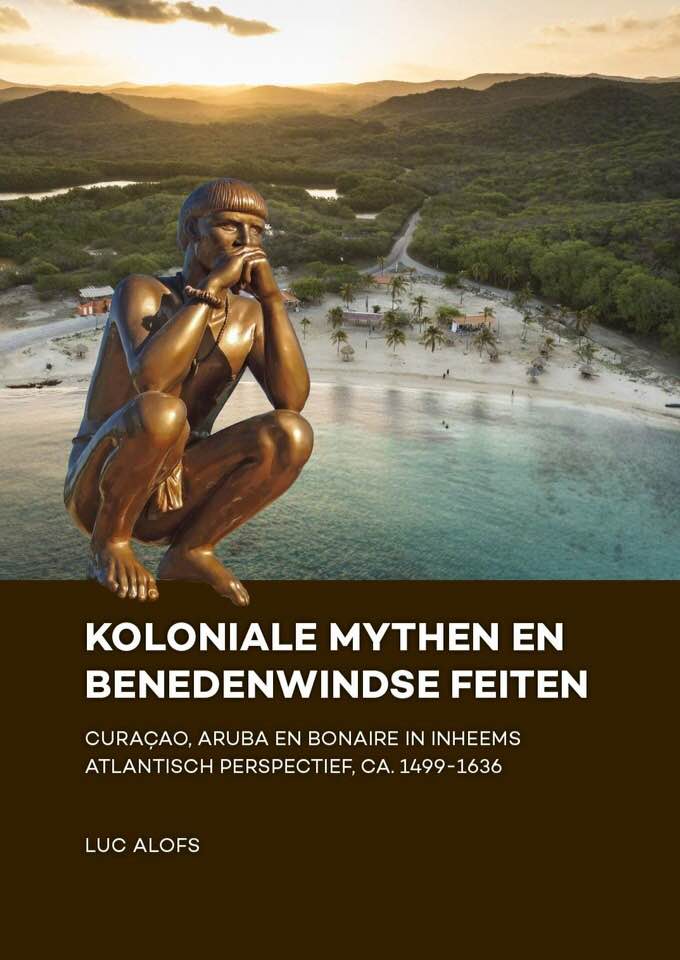Koloniale mythen en Benedenwindse feiten
De geschiedschrijving van de zogenaamd Spaanse periode van de Benedenwindse eilanden Curaçao, Aruba en Bonaire (ca. 1499-1634/6) wordt nog steeds gedomineerd door koloniale mythes over inheemse bewoners en Spaanse encomenderos. Inheemse bewoners worden beschreven vanuit een eurocentrisch perspectief ofwel als Giganten (Vespucci) ofwel als volgzame onderworpenen van Europese kolonisatie.
Al in 1588, verdedigde Juan de Castellanos in zijn ‘Elegías de los claros varones de Indias y la historia del Nuevo Reino de Granada’ het encomienda-systeem en prees hij de Benedenwindse encomendero’s Juan de Ampiés en Lazaro Bejarano. Twintigste eeuw historici reproduceerden deze koloniale verbeelding van de Benedenwindse eilanden. Europese nieuwkomers werden afgebeeld als de brengers van het christendom en humanisme of als oprichters van het (post) koloniale context van de Nederlandse Antillen.
Ook literatoren werden beïnvloed door deze koloniale mythen. In 1970 liet arts en dichter Chris Engels (pseudoniem: Luc Tournier) archeologisch onderzoek in Aruba uitvoeren om uit te vinden of de inheemse bevolking inderdaad Giganten waren. Cola Debrot baseerde zijn novelle De Vervolgden (1981) op het werk en leven van christenhumanist Bejarano. Humanist Frank Martinus Arion pleitte in 2003 zelfs voor het oprichten van een standbeeld voor Bejarano: ‘als de eerste Curaçaose bestuurder die zich met hart en ziel voor ons eiland heeft ingezet en zijn nut meer dan eens bewees. Bovendien was hij één van de eerste humanisten van de nieuwe wereld’. Deze publicatie is een exercitie in het deconstrueren van koloniale mythen en het tot stand brengen van een gedekoloniseerde inheems Atlantische Benedenwindse geschiedschrijving.
Koloniale mythen en Benedenwindse feiten; Curaçao, Aruba en Bonaire in inheems Atlantisch perspectief, ca. 1499-1636
Luc Alofs | 2018
ISBN: 9789088906015
Imprint: Sidestone Press | Format: 182x257mm | 176 pp. | Language: Dutch | 12 illus. (bw) | 28 illus.

The historiography of the so called Spanish period of the Leeward past (ca. 1499-1634/6) is still dominated by colonial myths about the indigenous inhabitants of the islands of Curaçao, Aruba and Bonaire and Spanish encomenderos Juan de Ampiés and Lazaro Bejarano. Indigenous inhabitants are described from a Eurocentric perspective either as Giants (Vespucci) or as docile subjects of European colonization. In 1588, Juan de Castellanos in his ‘Elegías de los claros varones de Indias y la historia del Nuevo Reino de Granada’ defended the encomienda system by praising De Ampiés and Bejarano. Twentieth century historians have reproduced colonial imagination. European newcomers are depicted as bringers of Christianity and humanism or as founders of the (post-) colonial context of the Netherlands Antilles.
Also, modern literary authors were inspired by these colonial myths. In 1970, medical doctor and poet Chris Engels (pseudonym: Luc Tournier) implement archaeological research in Aruba to find out if the native population were Giants. Cola Debrot based his novel The persecuted (De vervolgden, 1981) on the life and work of Christian humanist Bejarano. In 2003, humanist and author Frank Martinus Arion pleaded for the creation of a statue for Bejarano: ‘as the first Curaçao governor using heart and soul for our island and more than once proved its usefulness. In addition, he was one of the first humanists of the new world’. This publication is an exercise in the deconstruction of colonial myths and the creation of a decolonized native Atlantic Leeward historiography.

Waar in Curaçao is je boek te koop?